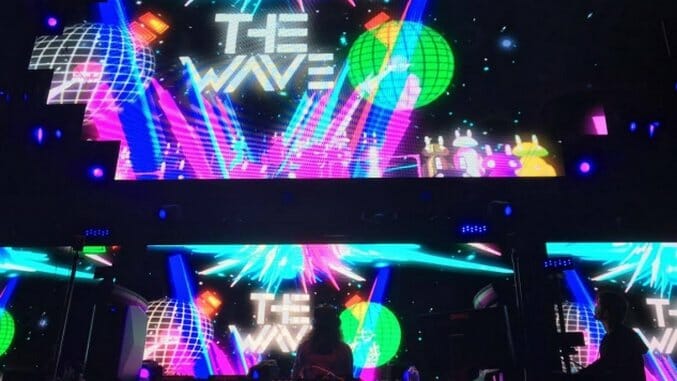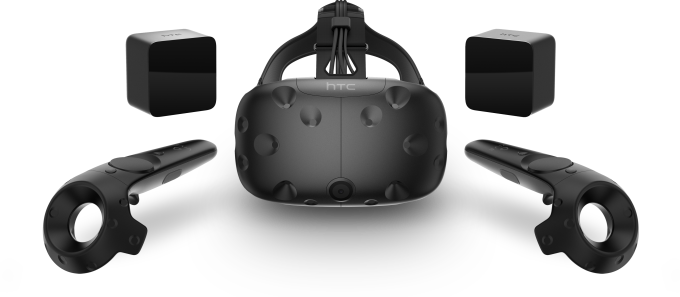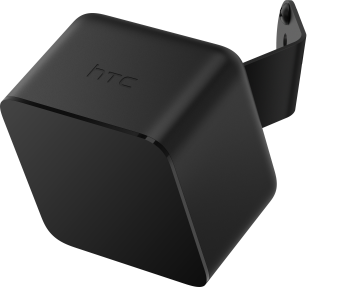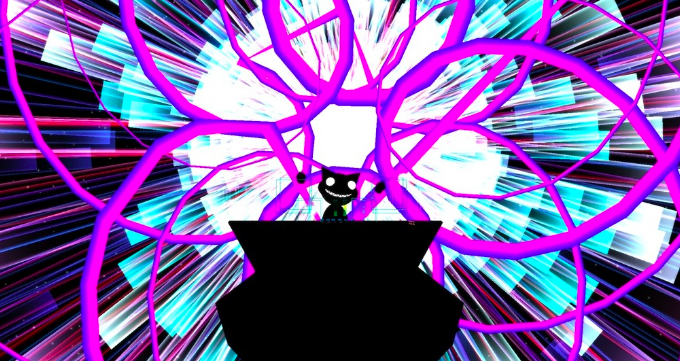
Aaron Lemke is the Chief Creative Officer of TheWave, a new “cross-platform virtual reality experience that lets users create music in totally new ways.” He’s sitting in a swivel chair oscillating between his computer and keyboard. There are a half-dozen guitars in the general vicinity. The computer’s monitor is perched on a stack of textbooks. The walls are covered in art and flyers about music events. It’s a space that reflects the diverse interests of Lemke.
Lemke says TheWave started as a whim. After spending over a decade playing music around Austin, which he describes as “the perfect place to grow up and be in a band,” Lemke began designing games. After college, he taught himself how to make games in Unity, the engine that has made videogame development far more accessible to those eager to learn. The Oculus Rift Kickstarter inspired him to start making VR experiences because it was, he says, way too cool not to.
At first, Lemke was making “mostly virtual nature mediation experiences.” He describes his creations in contrast to the standard shooter games that were being made. When other people were trying to freak people out, Lemke says, he was trying to find a way to chill them out.
But Lemke’s musical interest eventually kicked in. He said that he and his buddy (current CEO of TheWave, former Harmonix employee) both wanted to make something musical in the platform of VR. Lemke built the first prototype, then reached out to the company’s current CTO, Finn Staber, who “came in and made it a whole lot better.” They would later work with a DJ called Grimecraft and various 3D designers to create what is currently TheWave.
Lemke describes TheWave as something that can be more than just one new music interface, but infinite music interfaces that people can create on their own. To him, the simplicity of an interface makes it approachable.
“There’s a reason the piano has stuck around so long, it’s a great interface, all the keys are right out in front of you.”
Lemke says there is a “layer of abstraction” found in the actions of a DJ. The DJ’s movements are connected to sounds, but do not physically create them. He believes this adds a layer of control and finesse.
“In DJ-ing, it’s not an instrument you’re performing, it’s more of a toolset,” Lemke says. “Mix tracks together, do crossfades, and do stuff like that. So that the DJ interface, it’s less of an instrument and more a way of controlling sounds.”
Ultimately, Lemke wants to allow even greater musical merging by allowing TheWave to also record and capture music.
“We want you to be able to take your guitar and record some guitar and have that loop that you just recorded show up as a wave form inside of virtual reality. So that you can duplicate it, loop it, do whatever you want.”
The Hardware  TheWave operates relying on room-scale virtual reality, which means that people using the VR are able to actually walk around freely in the designated space.
TheWave operates relying on room-scale virtual reality, which means that people using the VR are able to actually walk around freely in the designated space.
“Also there’s something cool about VR, this level VR, where you have room-scale plus two hand controllers,” Lemke says. “Interacting with stuff with your hands that, that’s how you interact with everything.”
He picks up a spoon, drops it on the desk.
“That’s the interface that we’re best at: picking stuff up, looking at it, moving it around.”
Lemke’s aspirations for TheWave make it well suited for the HTC Vive, one of the most advanced VR systems currently on the market. With the Vive, the wearer uses a headset and two controllers that allow them to exist, move in, and interact with a virtual space. Haptic feedback and “intuitive” gestures create movement in this virtual world. Players count on the virtual “Chaperone guidance system” (a grid that appears when you are close to a wall) to keep them in the designated area.
 HTC’s VR system uses something called “”Lighthouse technology in order to track the user’s movements. The Vive is able to do this with just two Lighthouse boxes (in the base stations that come with purchase of the Vive system) placed diagonally across from each other. The space between the Lighthouse is the area of interaction.
HTC’s VR system uses something called “”Lighthouse technology in order to track the user’s movements. The Vive is able to do this with just two Lighthouse boxes (in the base stations that come with purchase of the Vive system) placed diagonally across from each other. The space between the Lighthouse is the area of interaction.
Like their namesake, the Lighthouses flood the room with flashes of light, allowing them to serve as reference points to the user’s headset and controllers. LED lights flash and a laser beam sweeps across the room. The headset and controllers are receivers, covered in tiny photosensors, that detect this light. The headset receiver counts down the moment between the flash and when one of the sensors detected the light. It uses that information to determine its position relative to the Lighthouses.
This level of precision is crucial to game play in the Vive. The precision allows for games with movements that accurately reflect the user’s gestures and graphics without distracting delays. For something like TheWave, where small gestures change the pitch of music and generate immediate sound, these factors are especially critical. The DJ has immediate and precise control over their music.
The Experience
The experience of TheWave is best described as “fully immersive.” The user steps into the designated area, puts on the headset and headphones, then enters a strange world of floating lights. In one of the DJ experiences, the user sees a series of vertical planes set at intervals. They can use the controller to add dots onto the planes. Each dot represents a musical note.
Pressing the play button sweeps a plane along that plays the notes at their intervals. It’s a bit like the turning spool of a music box that that plucks the notes. Above this area, there are floating orbs that can be grasped with the controllers. Moving the orbs left or right alters the pitch of the playing notes.
Turn around and there are other tools to play with. Two spheres are floating in wireframe cubes. Moving the spheres from the cubes alters the tones in different ways. For example, one of the spheres can be adjusted to create a sort of 8-bit sound that is a little crunchy.
There are a couple of sound boards, as well. Tapping the shapes on the boards produces various sounds. They can be looped to create sequences that will continuously play as the user creates a larger arrangement. Users can move freely within the space and are surrounded by their virtual sound tools. There is also a tool that lets them “teleport” into the audience and view their performance from a distance.
In another experience, the DJ is faced with a board of pre-added samples. They can pick them up and stick them to the controller, and even crossfade them. The current samples are credited to the DJ, Grimecraft. Ultimately, there are plans for an easy uploading system that prospective DJ’s can use to add their own sound samples.
It’s a very responsive system. After a minute or so, it seems almost natural to be existing in this strange space. It’s easy to start playing: move this, press this, add this. As the user listens to their composition, they can start to become familiar with their set up. The spatial layout makes it easier to remember the many different sound adjustments that can be made.
Overall, it’s an interesting and distinct experience. This new approach puts an especially strong sense of physicality into a type of music often associated with the digital realm. The controls are light and pleasantly ergonomic and though the headset could become a bit heavy after a while, the same could be said about a Fender Stratocaster.
The Future Lemke, has ambitious plans for TheWave.
Lemke, has ambitious plans for TheWave.
“We don’t want to mimic the traditional concert experience. We want to make something new that’s more transcendent, more broad.”
He believes that VR concert experiences could be beneficial to artists and audiences.
“There’s people all over the world who never get to see Tiësto because Tiësto doesn’t tour in the middle of Russia… It’s cool from an artist perspective because you have that broad reach.”
Lemke’s personal experiences within the Austin music scene as a musician and friend of musicians (he is buddies with Max Frost) make him sympathetic to the difficulties of touring and the narrow profit margins on ticket sales and merchandise. He’s thought about a lot of different models that could be applied to TheWave, including subscriptions, or the possibility of virtual merchandise in the form of branded avatars or similar forms.
The medium itself he describes as great for up and coming artists, given virtual reality’s ability to level the playing field.
“It’s hard to be an amateur and get gigs and have a good show,” he says. “Part of the problem is you have these big DJs that have laser shows and millions of dollars in production value.”
In the virtual world, they can be equal. Any DJ with the Vive can put on a digital show of epic proportion. Any audience member with VR headsets (cardboard, Gear VR, etc.) can view that show. Lemke explains that this can hopefully allow for more of a meritocracy by democratizing fabrication.
“[With TheWave], you don’t need a million dollars because you can create your set, your visuals, everything and it could be just as badass as Skrillex shows.”
Lemke recently took TheWave to perform at E3, but he has other ambitious plans for the future. At VR LA, TheWave will be making “the first big VR silent disco.”
“There will be someone on stage in the Vive, DJ-ing and a bunch people in the audience who have headsets and head phones,” he says. “They will all be networked into the same virtual space.”
TheWave, anticipated to have a public release this fall, is a very intriguing concept that could prove relevant to both the music and the gaming communities. It’s a particularly astute use of room-scale VR. TheWave is fun to play with, but it could also be used as a tool to make and perform music in unprecedented ways.